When it comes to marketing, it often feels like there’s always a new tool to learn or strategy to try. One marketing channel, however, has stood the test of time: email. Every year, private sector companies spend thousands of dollars building email lists to reach their target demographic. Schools like yours don’t have to do this. You already know who you need to reach, and you have the contact information to reach them—and it costs you absolutely nothing.
That puts you at a huge advantage. Businesses are willing to spend big bucks to get their audience’s email addresses because they understand one fundamental truth about marketing: Email is the best way to reach your audience. This is true now more than ever.
The State of Marketing Today
A lot has changed in the world of marketing. According to a recent Hubspot survey of over 1,200 marketers, 80% of them believe that “marketing has changed more in the past three years than in the past 50 years.” Perhaps this is because many forms of marketing are either becoming outdated or losing consumers' trust.
Skepticism of channels like paid advertising has grown, and with the rise of deep fake AI-generated media, organic content is under some pretty heavy scrutiny at the moment. While there’s no question that social media is addictive, the majority of people (even Gen Z) agree that social media is the least reliable source for information. It’s no wonder Americans’ trust in media is at a record low.
While all this may sound grim, it just means that people are turning to other channels to access information. One of these channels is—you guessed it—email. Almost 80% of marketers saw an increase in email engagement in 2022. Email boasts the highest ROI out of any marketing channel and consistently has a higher click-through rate than social media. It’s also the channel most people prefer to check first thing in the morning.
It may seem like I’m dogging social media, but the important thing to distinguish here is that email is one of the only channels you can control. Social media, digital ads, and some forms of traditional advertising are great tools for brand awareness—but they’re hosted on platforms you don’t own. That means you don’t control visibility or placement.
Take social media, for example. If someone hasn’t consistently engaged with you on Facebook, they may not see the important announcement you just made about school being canceled for the day. That’s because if someone isn’t engaging with your Facebook page, their Facebook feed deprioritizes your content over time. In other words, when you share your message on third-party platforms, you don’t know if you’re reaching everyone you need to reach when you need to reach them. Thankfully, email operates by a different set of rules. As long as you have your audiences’ email addresses, you can rest assured your message will reach them—whether or not they’re actively engaging with you.
As trust decreases and competition increases on third-party platforms, now is the time to take a second look at email marketing. You have full control over your school newsletter, and statistics don’t lie—people want to hear from you here. So where do you begin?
If you’re like most districts, you already have a school newsletter you’re regularly sending out to families and staff. The question is: Have you built a marketing plan around it? Your newsletter is one of the best ways to build relationships, establish trust, and attract new folks to your district. In order to do this, there are a few key principles to keep in mind: audience, content, and strategy. Let’s dive into all three.
Audience
Lately, I’ve been thinking about a quote from F. Scott Fitzgerald’s book The Great Gatsby: “I like large parties. They’re so intimate. At small parties, there isn’t any privacy.” I feel the same way about a well-crafted newsletter, only I’d phrase it a bit differently: I like newsletters. They’re so intimate. On social media, there isn’t any privacy.
Here’s what I mean. Your newsletter is a place to talk directly to a small group of people. You control the eyes that see your message, and your message isn’t diluted by other brand voices (unlike on social media). What makes email so powerful isn’t the design or the stuff you can see; it’s the ability to segment your audience into niche groups.
While some occasions call for districtwide announcements, you should aim to reach a small group of people within your community. People like families of the high school girl’s soccer team, elementary school teachers, or paraprofessionals. They all come under the wide umbrella of your district community but they represent very distinct groups—and very distinct groups require very distinct messages.
Segmenting your audience into smaller groups gives you the ability to use more informal language. What may have sounded stiff and impersonal in a districtwide email suddenly feels personal, timely, and authentic to a small group of people. This is where hospitality and relationship-building can really shine in your communication. It even helps your open rates. According to Dynamic Yield Research, 88% of people are more likely to respond favorably to emails that look tailored for them.
Creating highly segmented email lists is a lot like fostering a micro-community: a small group of people that share a common interest. The rise of online micro-communities, like Mastodon or Slack groups, represents the growing trend of people abandoning public platforms for private ones. As more and more people turn to these tight knit communities, we can infer that people want to feel a sense of belonging with like-minded folks in a space that feels more intimate and less crowded.
So how do you create a micro-community with your email lists? One way is to send out a survey and simply ask your community which groups they want to be a part of. You may even consider having a dedicated landing page on your website where your school community can sign up for the newsletter group of their choice.
The Atlantic’s newsletter’s landing page is a great example of this. Book lovers can sign up for “The Book Briefings,” and “The Weekly Planet” newsletter offers big ideas on how to care for our planet. There’s even a newsletter for crossword enthusiasts. By giving people the ability to opt into the newsletter of their choice, The Atlantic can send tailored content that piques their specific interests.
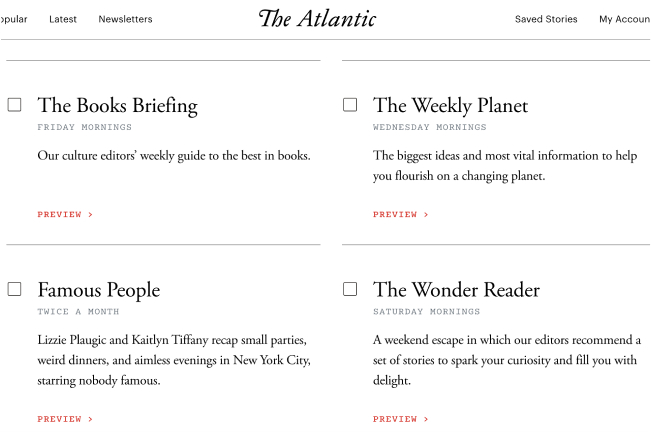
Giving your reader control over how they want to be reached is one of the best ways to establish trust and build relationships. It also helps decrease your unsubscribe rates; people are less likely to unsubscribe to content they opted into in the first place. If you haven’t already, consider adding a landing page on your website or sending out a survey giving people options.
But what happens to the families whose children graduate? How do you keep them engaged with your schools? Consider adding them to an alumni list or a list dedicated to the broader community at the end of their senior’s school year. This proactive approach is one small way to keep people from unsubscribing to your newsletter.
If you’re a small district at full capacity, this may not be the right approach for you—and that’s okay. There are plenty of other ways to engage your audience, even if you’re sending your newsletter to one big list. I’ll discuss those strategies in the next sections.
Segmenting your school newsletter list into niche communities (if you can manage it) is the first and most crucial step in email marketing. But it’s not enough to just segment. The best way to keep your readers engaged is to include content that’s personal, timely, and authentic to them. As you brainstorm new marketing strategies with your communications team, talk about ways to make your email lists smaller and highly segmented, just like a micro-community.
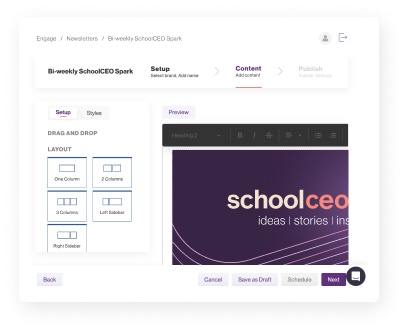
The Four C's for School Newsletters
So what do the best school newsletter templates look like? The best newsletters usually contain four elements in common: context, clarity, creativity, and consistency.
Context
The beginning of your newsletter should always provide context. People need to recognize your brand. They need to know who’s reaching out to them and why. Design and content both play an important role in this. Your logo and/or a banner image should always be at the top of your newsletter, and they should be consistent with your fonts and color palettes.
Some brands, like The Washington Post’s “The 7,” or On Being’s “Poetry Unbound,” actually give their newsletter a name, which you can see in their banner images.


Clarity
In addition to a banner image and logo, the most popular newsletters tend to have another element in common: an author and a send date. This small detail is easy to overlook, but it plays a huge role in establishing transparency with your reader. People want to know there is an actual person reaching out to them from behind the screen. They want to feel a sense of trust with your brand. Providing this information builds those cords of connection.
Saginaw ISD’s “Celebrating Leadership” newsletter is an excellent example of clarity. Here, you can see the name of the newsletter, “Celebrating Leadership,” along with their logo in the bottom right. Further down, you can see the author and send date underneath the banner image.
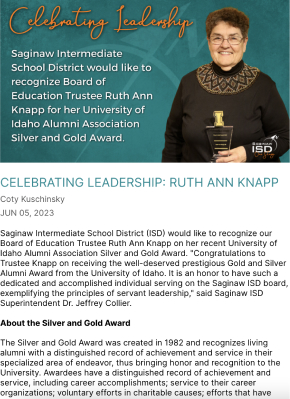
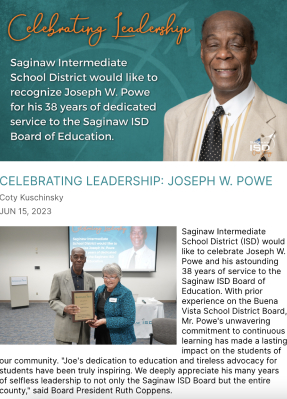
Creativity
There are plenty of different ways to incorporate creativity into your school newsletters. The best place to start is to ask yourself what you want the overall tone and goal of your newsletter to be. If your goal is to inform, consider trying the “letter” approach. This popular format usually incorporates a long intro that reads like a letter to the reader. It’s usually followed by a few updates, inspirational stories, and links to related content.
Hermantown Community School’s does a great job of this. Each month they send out their “Hawk Happenings” newsletter using the letter format, which always opens with a letter from superintendent Wayne Whitwam. His picture and signature at the bottom add an extra touch of personalization and authenticity.
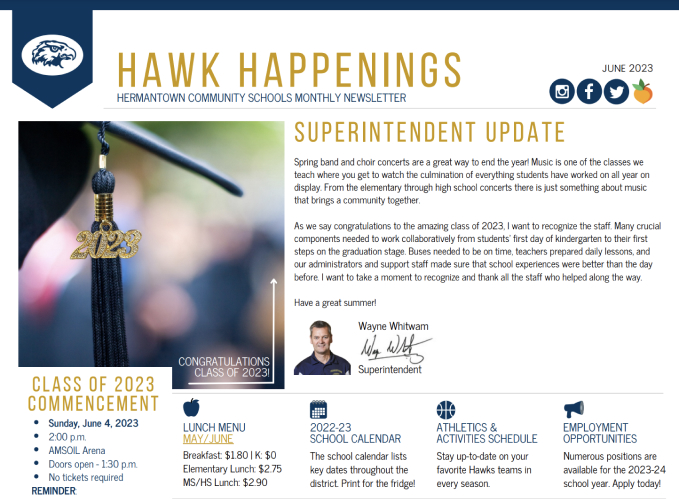
Here are a few more examples from The New York Times’ “Well” and “Where to Eat: New York City” newsletters. The key takeaway here is that this style is less about graphic elements and more about copy. You want your newsletter to read like a mini blog. Let your words, not design, do the talking.
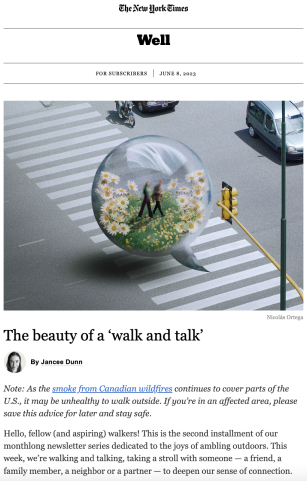

If your goal is to provide inspiration and to keep your newsletter short and sweet, try using a listicle format, like Farnam Street Media’s “Brain Food” newsletter. Their newsletter usually follows a similar pattern: one thought from Farnam Street, one Insight, one Tiny Thought, one Podcast recommendation, and an Etc. This allows them to break long-format, curated content into bite-sized information that’s easy to digest in a newsletter. If the reader is curious, they have the option to follow the source link to read the full articles.

Our SchoolCEO newsletter follows a listicle format. When you subscribe to our newsletter, we’ll send you:
- One question for you
- Two resources to help
- Three ideas to ponder
Subscribe to SchoolCEO Spark. Keeping 22,000 school leaders in the loop.
Your school newsletter is not just a tool for passing information. The best newsletters spark conversations and make the reader think. When it comes to creativity, consider how you want to end your newsletter. What do you want your reader to walk away thinking and feeling? Some brands, like James Clear’s “3-2-1 Thursday” newsletter, end on a question. He also adds a P.S. under his signature, usually with a link to a funny tweet or something lighthearted. These are subtle but powerful ways to humanize your brand and encourage two-way communication.
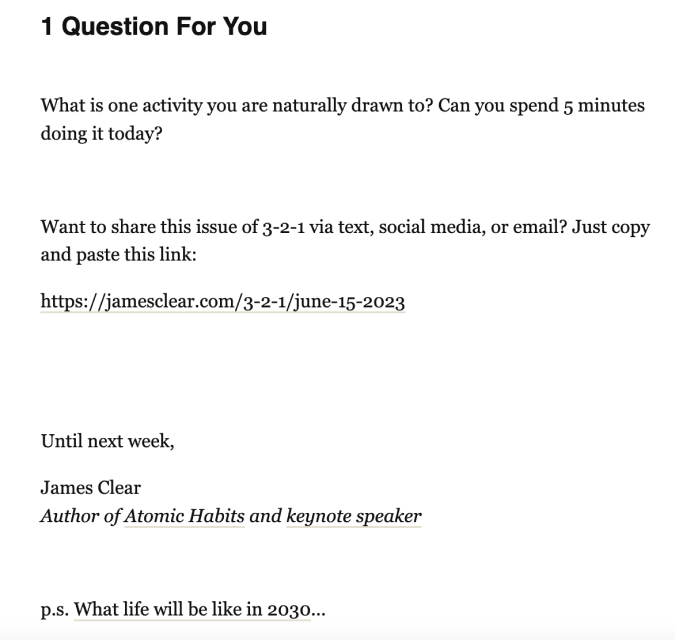
Consistency
The last of the four C’s is consistency. Consistency is a thread that weaves through every aspect of school marketing, including your newsletter. If you want people to commit to reading your newsletter, you have to commit to sending it to them. That means sending it on the same day, week, or month consistently. This establishes a cadence your readers can depend on—which again, goes back to the main theme of this article: trust. As Zig Ziglar puts it, “If people like you, they'll listen to you, but if they trust you, they'll do business with you.”
Think about your favorite podcast and TV show. As brutal as it is to wait for the next episode, we feel some reassurance knowing that the next one will be released in a given timeframe. The same concept applies to your school newsletter. When you commit to showing up for your audience on a given day or time, they’ll learn to trust you, and if they trust you, they’ll stay loyal to you.
Practically speaking, that means choosing a publishing schedule that’s realistic for you. Quality is more important than frequency here. In fact, 63% of businesses in 2022 reduced their email frequency based on reader engagement. Start with a conservative timeframe, like monthly or biweekly, and commit to mastering that. Over time, you may find you have the capacity and resources to increase the volume. If you decide to increase your publishing frequency, be sure to give your readers a heads-up. That small act of thoughtfulness and communication goes a long way.
Strategy
This leads us to a broader conversation about strategy. By now you may be wondering: When is the best day, time, and frequency to publish? And how do I know my school newsletter is performing well?
As far as frequency goes, research suggests that you should be sending a newsletter at least once a month and no more than twice a week. The majority of consumers want to hear from you once a week, but take these statistics with a grain of salt. Remember: Quality is more important than frequency.
As for the best day of the week, about half of all marketers claim there isn’t a perfect time or day to send emails. The other half contradict each other—some say Monday, others say Tuesday, and still others suggest Thursday. That being said, the majority of marketers agree the weekdays are the best days to send an email.
What about time? Again, the research is inconsistent, but the majority of marketers, including HubSpot, say emails sent between 9 a.m. to 3 p.m. on weekdays tend to perform best. While it’s important to stick to a consistent publishing schedule, don’t be afraid to A/B test and find out what time of day works best for your readers. I like what John Bonini from Databox had to say about timing: “A better question to ask would be, Is there a best time for our company to send email given what we know about our subscribers? ”
Lastly, an easy way to measure newsletter success is to track your unsubscribe rate. Private sector newsletters typically focus on list growth. But since schools already have their community's email addresses, your focus should simply be keeping people from unsubscribing. This goes back to my point earlier about families unsubscribing from your newsletter after their students graduate. How do you keep your community active and engaged with your newsletter even if they no longer have children at your schools?
As America’s trust in media channels like paid advertising and social media wanes, now is the time to invest in your school newsletter. With complete access to your audiences’ email addresses, you’re already several steps ahead of the curve compared to the private sector. Email is a space to build relationships, provide timely information, and nurture trust with your community online. By segmenting your audience into micro-communities and using the four C’s to craft engaging content, your newsletter may just become your audience’s favorite channel to stay connected with you.
Read More Apptegy Resources
School newsletters are all the rage. Does yours stand out?
Here's how to make your school newsletter worth opening week after week.
Why you need word-of-mouth marketing (and how schools can apply it)
What's the secret to going viral? Try word-of-mouth marketing.
This district recovered from a damaged brand. So can you.
How Minnesota's GFW Schools regained their community's trust—and how you can do the same.
